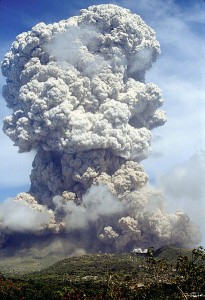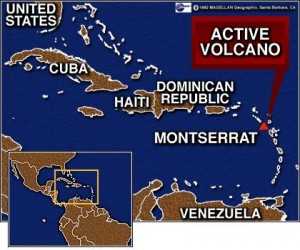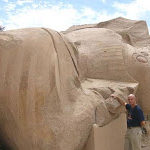Montserrat Island is a mere 40 sq mi of land surface and has been the ‘target’ of enormous natural disasters. In 1989 destructive hurricane Hugo virtually wiped out the entire island and in 1995 its main volcano blew up and made a wasteland of the entire southern half of the island. Any modest sign of gay life was decimated as most of the population escaped to other islands or to the north end of Montserrat. Recovery as an island paradise has been partial but it will never be the same. Gays are everywhere but hardly here.
Montserrat is a island that has known great suffering in the past 20 years, not as in Africa from ethnic warfare or in the Middle East from religious sectarianism or in Russia from political repression. Rather, this island territory of a mere 104 km2 (40 sq mi) of land has been the ‘target’ of natural disasters. In 1989 destructive hurricane Hugo nearly wiped out the entire island and in 1995 its main volcano blew up and made a wasteland of the entire southern half of the island. (photo right)
More than half of the population was relocated to the northern half or to adjacent islands or to the UK. Today the volcanic half, including the former capital city and major port of Plymouth–now a ghost town–is a no-go zone, too risky for human visitation due to unstable underground activity and unpredictable pyroclastic flows. However, the volcano is today touted as a tourist attraction–from a distance. On February 11, 2010 the already half buried airport was completely buried by more volcanic flows. Since then, the volcano has been relatively quiet.
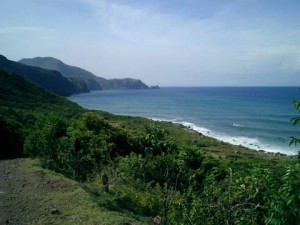 Despite the volcanic activity, the northern half remains verdant, forested, scenic with beaches, underwater coral reefs and hotels that currently attracts thousands of tourists, although far fewer than before. Much of the island’s native population has returned, with estimates ranging from 4,700 to 9,500, compared to the pre-Hugo/Volcano high of over 12,000. In February 2005, a new airport opened at Gerald’s in the north. As of 2011 it handles several flights daily operated by Fly Montserrat Airways. Docking facilities are in place at coastal Little Bay, where a new capital town is being constructed. The current government center is at Brades town, a short distance away.
Despite the volcanic activity, the northern half remains verdant, forested, scenic with beaches, underwater coral reefs and hotels that currently attracts thousands of tourists, although far fewer than before. Much of the island’s native population has returned, with estimates ranging from 4,700 to 9,500, compared to the pre-Hugo/Volcano high of over 12,000. In February 2005, a new airport opened at Gerald’s in the north. As of 2011 it handles several flights daily operated by Fly Montserrat Airways. Docking facilities are in place at coastal Little Bay, where a new capital town is being constructed. The current government center is at Brades town, a short distance away.
Gay Life
Fortunately, like nearby French Guadeloupe (and unlike nearby St Kitts and Nevis) homosexuality is a legal status in Montserrat, thanks to the governing UK laws that inform the laws in Montserrat (as a former colony). Since Montserrat is a British overseas territory, homosexual acts are as legal as in UK, expressly legalized under the United Kingdom’s Caribbean Territories (Criminal Law) Order, 2000.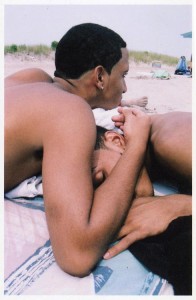
It hardly needs to be said that a mere remnant LGBT (gay) population live here; their numbers are probably fewer than a thousand, most of whom are likely to be married to the opposite gender to hide their secret feelings and more than a few on the ‘down-low’ seeking quick pleasure or perhaps a long term affair of the heart.
Finding any public expression from this hidden community is virtually impossible. Gay life happens behind closed doors here and even then, not much. The culture here is conservative. It is not a place to come to see LGBT life and no place to come to celebrate Pride. But come and spend some pink dollars; they need it.
The following comments were found on this GayBars website.
This description is overly suggestive and exaggerated. There are no gay bars on Montserrat–perhaps some are gay-friendly at best. But there is much natural beauty in the north hills and forests and under water.
“Beaching and the exploration of natural beauty in Montserrat are two of the main reasons tourists flock to this favored Caribbean island. No matter what brings you to Montserrat, you will definitely not be short of things to do or things to see and will have plenty of fun. Whether you are unwinding by the beaches, snorkeling, or having a good time in Montserrat gay bars, you will leave with memories that will last a lifetime.
“Rendezvous Bay is one of the most popular beach areas in Montserrat, and its name suggests much for your imagination. Rendezvous Bay is a beach where you can expect pretty much anything goes, and is also the only white coral sand beach located in Montserrat. Here you can check out the locals and soak up the Montserrat sun for as long as you like. After you have taken in your pleasures at Rendezvous Bay, be sure to continue them into the wee hours of the morning at Montserrat gay bars.”
Some History
The island is only 16 km (9.9 mi) long and 11 km (6.8 mi) wide. It was (an is) nicknamed the Emerald Isle of the Caribbean because of its similarity to certain coastal areas of Ireland as well as for the Irish ancestry of some of its inhabitants.
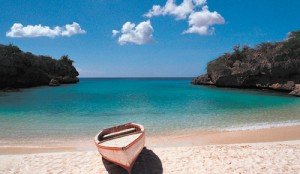 “Montserrat was populated for many hundreds of years by Arawak and Carib native people who were interrupted by Christopher Columbus on his second voyage in 1493. With usual arrogance he named the island Santa Maria de Montserrat, after the Monastery of Montserrat in Catalonia. The island fell under English control in 1632 when anti-Catholic violence in Nevis forced many Irish, who had been unwillingly transported from Ireland as indentured servants, to settle in Montserrat. As well, many Irish people arrived–brutally–as slaves to the island, some of whom were political prisoners sent there by fanatical protestant reformer Oliver Cromwell in his mid 17th century purge of Catholics from the UK.
“Montserrat was populated for many hundreds of years by Arawak and Carib native people who were interrupted by Christopher Columbus on his second voyage in 1493. With usual arrogance he named the island Santa Maria de Montserrat, after the Monastery of Montserrat in Catalonia. The island fell under English control in 1632 when anti-Catholic violence in Nevis forced many Irish, who had been unwillingly transported from Ireland as indentured servants, to settle in Montserrat. As well, many Irish people arrived–brutally–as slaves to the island, some of whom were political prisoners sent there by fanatical protestant reformer Oliver Cromwell in his mid 17th century purge of Catholics from the UK.
The big event of 1979 happened when the Beatles producer George Martin opened his AIR Studios Montserrat and the island attracted world-famous musicians who came to record in the peaceful, quiet and lush tropical surroundings of Montserrat. However the hurricane ten years later and the volcano explosion in 1995 put an end to that enterprise and decimated tourism.
The people of Montserrat have British citizenship as of 2002.
The local newspaper is the Montserrat Reporter
Compiled by Richard Ammon
GlobalGayz.com
September 2012
Also see:
Google Photo Gallery for Montserrat
Montserrat Holds National Pre-Festival HIV/AIDS Symposium

